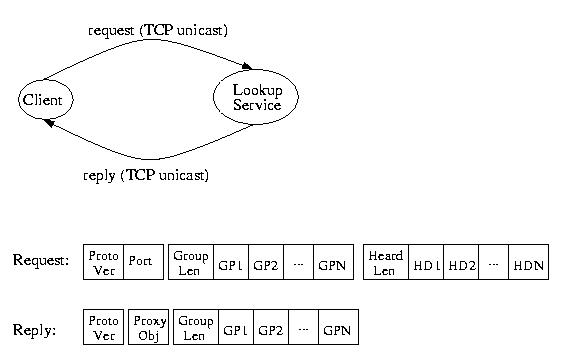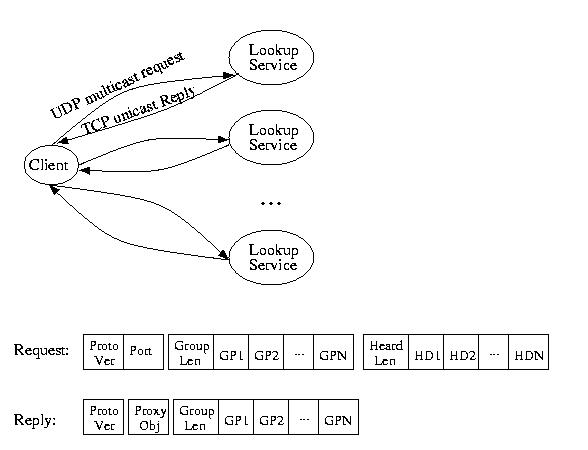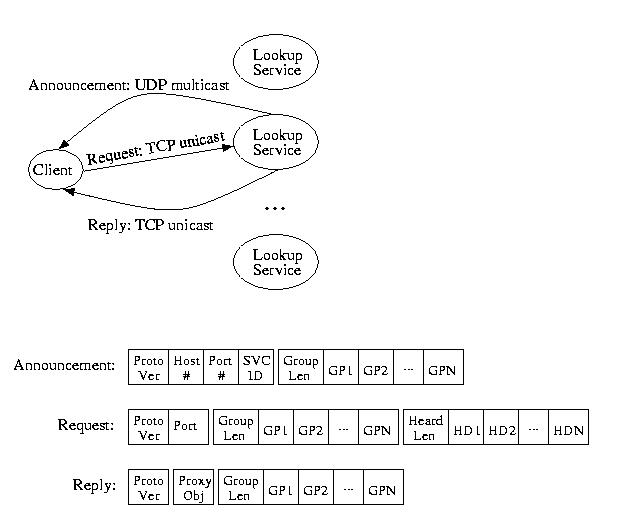Return to the lecture notes index
April 13, 2005 (Lecture 35)
Jini: A Very Brief Introduction
The original purpose of Java wasn't to produce cool Web pages. Java,
then known as Oak, was to be a language for the development of cooperating
embedded systems. Although Java in many ways went another direction, or
at least became prominent in a different arena, Sun didn't stop work
on distributed embedded systems. This work, influence by Java and many
of its developers, continued forward. An important piece of this
effort is the Jini project. The Jini system is the toolkit fom this
research group. It is a collection of tools to facilitate the networking
of embedded devices in a spontaneous network -- in many ways a toolkit for
ubiqitious computing.
The Jini Lookup Service
As you might imagine, mobile embedded device might have the need to
interact with other mobile and non-mobile devices. They might do this
via Java's RMI and remote methods. But, to do this, they will need
to know which system hosts the service and they will need a proxy
object for the service. It is the role of the lookup service to
provide these things. Jini clients can query a lookup service
for these items by interface (the class of object they need),
by attributes that describe the class (in room 302, a printer, a
color printer, &c), or by a specific, unique service number (if known).
Additionally, Jini clients can request that the lookup service
inform them if new services become available -- this is much like
specifying a "future search". In many ways, the Jini lookup service
is a combined name service (search by id) and directory service
(search by attributes or type).
The details of the interaction between the client and the lookup service
are a little uninteresting and largely take the form of the
class specifications that define the interface. This would get a little
boring to look at and doesn't contain too many surprises. If you're
interested in the details, you might want to check Core Jini
by W. Kieth Edwards.
The Jini Discovery Service(s)
The lookup service is certainly a useful utility. But it doesn't
entirely solve the problem. Instead, in typical distributed systems
fashion, it moves a piece of it. Given a lookup service, we can now
find the service that we want. But, how do we find the lookup service?
To solve this problem, Jini includes three different discovery protocols.
One of them solves the problem in the easy case: the client knows
how to contact the lookup serice already. The other two tackly the
problem in the more difficult, "serendipitous" case -- where the
clients and the lookup service need to find each other first.
But, before we dive into the details of the discovery protocols,
let me mention a bit of an administrative detail. Jini services,
including lookup services, are members of administrative groups.
Examples of groupsat a University might be organizations such as
ECE, CSD, HCI, LTI, &c. Services and clients that are members of
only certain grousp may be "within earshot" of each other. As a
result, the discovery protocols allow clients to limit their queries
to certain groups.
The Easy "Hard Wired" Case
Let me suggest for a moment that the Jini client knows exactly
how to contact a particular Jini lookeup service. If this is
the case, no black magic is needed. The Jini client can simply contact
the lookup service via a TCP unicast, make its request, and get
the answer. The answer tells the client which groups the
lookup service handles and provides the clinet with the necessary
proxy object. The request will contain the following pieces:
- Header: Protocol version, client port number for response
- Group list: List of groups in which the client is interested
- Heard from list: A list of services the client already knows
about and, as a consequence, does not want to hear about again.
This is an optimization and can be omitted.
The client will get a reply from the discovery service that includes
the proxy object for the service, as well as a list of the groups
handles by the lookup service (note: this is a list of the groups
handled by the lookup service, not the discovery service that is answering).
The process is shown in the figure below:

Client-Initiated
The "hard wired" protocol above is nice and all, but it really doesn't
help us in the type of spontaneous environment that makes this problem
interesting. What if the client doesn't know what discvoery services
might be available? What does it do?
Jini provides another protocol to solve this problem (well, actually two).
This protocol allows a client to multicast to a well-known address
and "yell out" and ask nearby discovery services for help. What do
I mean by "nearby". This is defined by the scope parameter
of the UDP multicast. I'll leave the details of this protocol to
a networking course such as 15-441 (multicast is a little ugly). But for
the moment, let's just say that the scope is the number of "hops" that
the multicast can travel on the network. This scope prevents the whole
Internet from becoming one mess of screaming questions and answers.
Nearby discovery services (those within range of the multicast) then
respond to this request exactly as they would have if it was the unicast
request that we discuss above. The request and reply format are
both exactly as they were before. The only big difference is that the
request is sent by UDP, whcih imposes a limit on the packet size.
If the request is too long, all or part of the "heard from" list may be
omitted to obey the UDP maximum packet size restriction.
The client initiated discovery procedure is shown below:

The Jini specification requires that clients wait a random amount
of time after booting before beginning the mutlicast. This is
to prevent a multicast storm if many Jini devices are simultaneously
enabled. The specification also recommends that initializing Jini
devices perform seven rounds of multicasts, with a five seconds delay
between rounds. I don't know why 7 and 5 are favorite numbers --
perhaps just favorite sensible values.
Lookup service Initiated
When a new lookup service is initialized, and periodically throughout
its life, it advertises itself to nearby clients. Much as was the
case with the client-initiated protocal, the advertisement, known as
an announcement is done via a UDP multicast. After the announcment,
client can make requests to the lookup service exactly as discussed
in the section on the "hard wired" protocol -- the announcement provides
the necessary information. The process is illustrated in the figure below:

In addition to announcing their presence upon initialization, the
Jini specification recommends that lookup service re-announce their
presence ever 120 seconds. I don't know why 120 seconds was selected
as the period in between retrys.
Lessons Learned
The Jini discovery service is an excellent example of a discovery
service. These three protocols, allow for a Jini system to
initalize, manage failures, and "heal" without the intervention of
human administrators. As a distributed system becomes larger,
failures become commonplace, partionings become commonplace,
users change equipment frequently, &c. The administrative task is
larger than people can manage. This is especially true in mobile and
other rapidly reconfiguring environments. To operate in this environment,
a discovery service (as opposed to a simple directory service) is
needed.
As is the case with Jini, these services typically make use of limited
scope broadcasts and unicasts, timeout periods, and redundancy. They must
be able to work through failure.
On The Subject of Jini...Leases
While we are on the subject of Jini, I'd like to mention one interesting
facet of the system. Much like George Washington, the inventors of
Jini did not believe in permanant alliances. They never give a client
a permanant right to use a service. Instead they grant a client a
limited term lease. In order to continue to use a service, a client
must periodically "show interest" in the service by renewing the lease.
Jini actually allows some interesting options when it comes to leases:
lease managers can manage leases on behalf of services, and third parties
can show interest in leases on behalf of the lease holder.
Leases are useful, because they help Jini recover from failure. In the
event of a failed service, the system will correct itself after the lease
expires -- the client no longer expects the failed service. If a client
fails, the resource automatically becomes available again after the term
of the lease, because it is unable to show interest to maintain it. In
this way, Jini plans for failure and makes the recovery a normal and
expected procedure, not an exceptional one.
The Jini notion of a lease is not unlike leases in the other contexts
we've discussed this semester. Eliminate wastage and overhead by
offering resources only temporarily. Then, they can't get lost and they
don't need to be tracked -- even if they might go unused for a short
term at the end of the lease.


